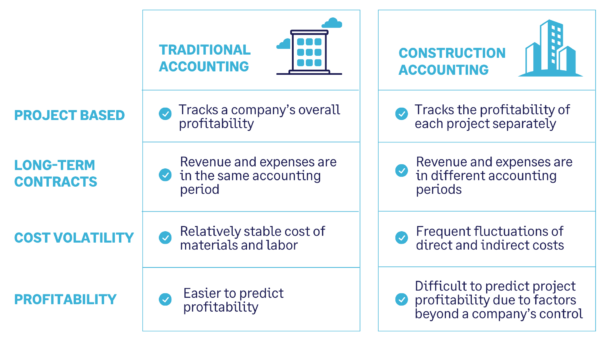Comprehending the Fundamentals of Construction Accounting for Better Financial Management
Comprehending the Fundamentals of Construction Accounting for Better Financial Management
Blog Article
A Comprehensive Guide to Building And Construction Accountancy: Maximize Your Financial Management
Efficient monetary monitoring is crucial in the building and construction sector, where the complexities of project-based income and costs can substantially impact overall earnings. A detailed overview to building and construction accounting provides useful understandings right into work setting you back, budgeting, and expense tracking, tailored especially for the unique challenges faced by professionals in this field. By utilizing finest methods in monetary coverage and analysis, stakeholders can not only enhance operational efficiency yet also mitigate potential threats. Recognizing these concepts is crucial, as they lay the foundation for making educated choices that can change monetary results. What techniques may be most advantageous for your organization?
Comprehending Construction Audit
Comprehending construction audit is crucial for the successful monitoring of funds in the construction industry. This specific branch of audit addresses the special challenges encountered by construction companies, consisting of project-based income acknowledgment, expense monitoring, and compliance with governing requirements. Unlike standard accounting, building and construction accounting requires an unique strategy to handle the intricacies associated with lasting contracts and changing prices.
Key parts of construction audit include precise profits acknowledgment, which often relies upon the percentage-of-completion approach or completed-contract method, depending upon the task's nature. This ensures that monetary declarations mirror true performance and profitability in time. Moreover, work costing plays a crucial role, enabling companies to track expenses related to specific jobs, which aids in determining earnings and resource allocation.
An additional essential facet is the monitoring of cash circulation, which is commonly impacted by settlement routines and hold-ups in receivables. Effective capital monitoring ensures that building firms can satisfy functional needs and buy future projects. Eventually, understanding building accounting furnishes firms with the devices needed to make enlightened financial decisions, minimize threats, and improve total operational efficiency in an affordable market.

Job Costing and Budgeting
Task costing and budgeting are essential components of construction bookkeeping that enable companies to successfully handle task finances and make sure success. Job costing entails the thorough monitoring of all expenses connected with a specific job, consisting of labor, materials, tools, and overhead. This procedure permits building firms to establish truth cost of completing a job, facilitating notified decision-making and boosting monetary accountability.
Budgeting, on the various other hand, serves as a financial roadmap for jobs. It entails setting economic limits and designating sources to numerous project components, thus establishing a structure versus which actual expenses can be measured. Efficient budgeting calls for extensive evaluation and forecasting, thinking about historic information, market trends, and prospective threats.
Together, job setting you back and budgeting provide the needed tools for building and construction firms to check monetary performance, identify differences, and change methods as required - construction accounting. By applying robust job costing practices and adhering to well-structured budgets, firms can improve their functional performance, minimize economic risks, and ultimately boost their profitability in an affordable market. Therefore, these practices are essential for maintaining long-term success within the building sector
Tracking Expenditures and Revenue
Accurately tracking expenses and revenue is important for building firms to keep economic health and make sure job practicality. Reliable tracking enables organizations to monitor job performance, determine expense overruns, and make notified economic decisions. Carrying out a methodical technique to taping all monetary deals is important to accomplishing this objective.
Making use of building and construction audit software program can dramatically boost the tracking process. These tools help with real-time monitoring of expenses, consisting of labor, products, and subcontractor costs, while also recording earnings created from job turning points and client settlements. By classifying costs and revenue streams, companies can get understandings into earnings and cash money flow.

Financial Coverage and Evaluation
Economic coverage and analysis play a critical role in the construction market, giving stakeholders with vital insights into a firm's financial performance and functional effectiveness. Accurate financial reports, consisting of annual report, earnings declarations, and capital statements, are essential for evaluating the health of a building and construction company. These documents help recognize patterns, examine task productivity, and facilitate notified decision-making.
In building and construction audit, economic analysis surpasses plain reporting; it involves scrutinizing economic information to reveal underlying patterns and anomalies. Secret efficiency indications (KPIs), such as gross earnings margins, task completion prices, and return on investment, function as benchmarks to evaluate operational success. Consistently assessing these metrics allows firms to determine areas requiring enhancement, optimize source appropriation, and improve job management techniques.
In addition, reliable monetary coverage promotes transparency and builds depend on pop over here with stakeholders, including clients, vendors, and capitalists - construction accounting. By keeping strenuous economic oversight, building and construction companies can reduce risks, make sure conformity with governing demands, and ultimately drive sustainable development. Hence, a robust economic reporting and analysis structure is essential for navigating the complexities of the building and construction landscape and achieving long-term success
Ideal Practices for Success
To achieve success in building and construction accounting, companies need to adopt a set of best techniques that streamline operations and improve financial management. Initially, executing a robust job monitoring software application tailored for building and construction can assist in real-time monitoring of project expenses and budgets, enabling even more exact projecting and source allotment.
2nd, taking on a constant company website strategy to job setting you back is important. This entails diligently tracking all expenses connected with each task, including labor, materials, and overheads. On a regular basis examining task costs against initial price quotes helps identify differences early, enabling timely corrective actions.
Third, keeping rigorous documents methods guarantees conformity with policies and simplifies audits. This includes keeping comprehensive records of contracts, modification orders, invoices, and invoices.
Additionally, purchasing team training is vital. Ensuring that workers are well-versed in accounting principles, software application use, and industry requirements can dramatically boost efficiency and precision in monetary coverage.
Verdict

Report this page